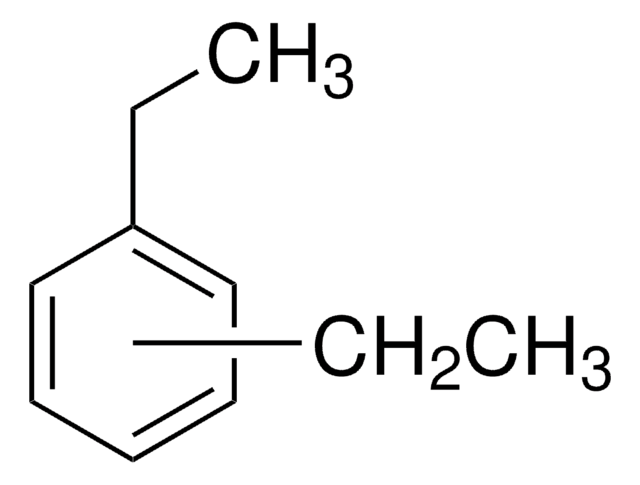302937
Perfluoro(methylcyclohexane)
technical grade, 90%
Synonym(s):
(Trifluoromethyl)undecafluorocyclohexane, Perfluoromethylcyclohexane
Sign Into View Organizational & Contract Pricing
All Photos(1)
About This Item
Linear Formula:
C6F11CF3
CAS Number:
Molecular Weight:
350.05
Beilstein:
1915981
EC Number:
MDL number:
UNSPSC Code:
12352100
PubChem Substance ID:
NACRES:
NA.22
Recommended Products
grade
technical grade
Quality Level
Assay
90%
form
liquid
refractive index
n17/D 1.285 (lit.)
bp
76 °C (lit.)
density
1.787 g/mL at 25 °C (lit.)
functional group
fluoro
SMILES string
FC(F)(F)C1(F)C(F)(F)C(F)(F)C(F)(F)C(F)(F)C1(F)F
InChI
1S/C7F14/c8-1(7(19,20)21)2(9,10)4(13,14)6(17,18)5(15,16)3(1,11)12
InChI key
QIROQPWSJUXOJC-UHFFFAOYSA-N
Looking for similar products? Visit Product Comparison Guide
General description
Mixtures of chloroform and perfluoro(methylcyclohexane) can be used as solvents for "fluorous" biphase reactions. Gas-phase structure of perfluoro(methylcyclohexane) was investigated.
Application
Perfluoro(methylcyclohexane) can be used as:
It can also be used as a solvent to investigate fluorophilicity of a series of hydrocarbon and fluorocarbon-functionalized nicotinic acid esters.
- A reactant to synthesize perfluoro-2-methylcyclohex-1-enolate by photochemical reaction with tetrabutylammonium iodide in water.
- A fluorous solvent to synthesize polynorbornene via ring-opening metathesis polymerization (ROMP) of norbornene using fluorous Grubbs′ second-generation catalyst.
It can also be used as a solvent to investigate fluorophilicity of a series of hydrocarbon and fluorocarbon-functionalized nicotinic acid esters.
Perfluoro(methylcyclohexane) was employed as solvent to investigate fluorophilicity of a series of hydrocarbon and fluorocarbon-functionalized nicotinic acid esters.
Storage Class Code
10 - Combustible liquids
WGK
WGK 3
Flash Point(F)
Not applicable
Flash Point(C)
Not applicable
Personal Protective Equipment
dust mask type N95 (US), Eyeshields, Gloves
Choose from one of the most recent versions:
Already Own This Product?
Find documentation for the products that you have recently purchased in the Document Library.
Customers Also Viewed
John T Gerig
Journal of the American Chemical Society, 127(25), 9277-9284 (2005-06-23)
Mixtures of chloroform and perfluoro(methylcyclohexane) can be used as solvents for "fluorous" biphase reactions since they exist as two separate phases at low temperature but become a single phase at higher temperatures. Intermolecular nuclear Overhauser effects have been used to
Kyle J Alvine et al.
Physical review letters, 97(17), 175503-175503 (2006-12-13)
The filling behavior of a room temperature solvent, perfluoromethylcyclohexane, in approximately 20 nm nanoporous alumina membranes was investigated in situ with small angle x-ray scattering. Adsorption in the pores was controlled reversibly by varying the chemical potential between the sample
S S Yang et al.
Biology of the neonate, 87(1), 60-65 (2004-10-07)
To test the hypothesis that intrapulmonary perfluorochemical (PFC) liquid may induce hypothermia, and to compare the effects of internal (IC), external (EC), and combined cooling techniques (EC + IC), 14 juvenile rabbits were randomized to EC by a cold blanket
Mei-Jy Jeng et al.
Critical care medicine, 34(4), 1099-1105 (2006-02-18)
To investigate the therapeutic effects of bronchoalveolar lavage (BAL) with either diluted surfactant (SBAL) or perfluorochemical liquid (PBAL), followed by either conventional mechanical ventilation (CMV) or partial liquid ventilation (PLV), on lung injury and proinflammatory cytokine production induced by meconium
Stephanie S Adkins et al.
The journal of physical chemistry. B, 112(15), 4760-4769 (2008-03-28)
The technique of hydrophobic ion pairing was used to solubilize the lipase from Candida rugosa in a fluorinated solvent, perfluoromethylcyclohexane (PFMC), in complex with a perfluoropolyether (PFPE) surfactant, KDP 4606. The enzyme-surfactant complex was determined to have a hydrodynamic diameter
Our team of scientists has experience in all areas of research including Life Science, Material Science, Chemical Synthesis, Chromatography, Analytical and many others.
Contact Technical Service









![Poly[4,5-difluoro-2,2-bis(trifluoromethyl)-1,3-dioxole-co-tetrafluoroethylene] dioxole 87 mol %](/deepweb/assets/sigmaaldrich/product/structures/951/320/21327fcd-4960-402d-8ae1-bf2e379cb2e2/640/21327fcd-4960-402d-8ae1-bf2e379cb2e2.png)